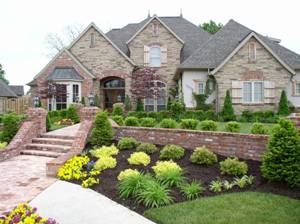For the home owner, the term landscaping encompasses many different things. But there are two primary keys to successfully landscaping a property – Planning and Knowledge. In this article we will look at planning stage.

Figure 1 - Well landscaped house
Planning:
Unless you are quite wealthy, the best way to landscape a home is to break the complete project into a group of smaller sub-projects. The completion of the smaller project, when completed, will provide you with the look and comfort that you truly desire, even if it takes a number of years to complete.
However, breaking the project into a number of sub or smaller projects will only have a successful outcome if you have a vision and layout of the entire landscaping project.
With advances in software, you can now create 3 dimensional plan of your landscaping and see it before you plant the first shrub. Having the plan in 3D allows you to conveniently break the total project into a number of smaller projects and see what each will bring to the total project as they are completed.
Additional information on 3D home and landscape design packages.
Many homeowners waste hundreds if not thousands of dollars, landscaping portions of their properties and without consideration for the entire project.
As an example, if you will desire lighting throughout your landscaping it is wise to install the entire underground conduit system at the same time, as this will avoid having to dig up finished portions of the total project in order to run an additional conduit to an outlying area.
This also applies to piping for underground sprinkler systems. Items such as conduit and piping are inexpensive and it is not necessary to buy the valves and wiring, as the case may be, until that portion of the project is undertaken.
In the same light why install a two zone sprinkler manifold when the finished project will need a three zone manifold. The extra zone can be capped off until required.
If your project is installing concrete patios or driveways, paving a driveway, installing a deck, placing brick pavers or flagstone it is always a good investment to install at least one if not two 2 inch diameter PVC conduits below the surface and at least a foot on either side of the installation, as shown in Figure 2, even if, at this point in time, you have no plans or concepts for how they might be used. Make a drawing or sketch of where the conduits are located, or if you are using a landscape software package - show the locations of the empty conduits on the plan.

Figure 2 - Capped PVC conduit buried under concrete driveway or sidewalk
By installing the conduits you will have given yourself the ability to run additional pipes, tubing, cable or wires under the project without having to dig it up and redo it.
As with any project, big or small, proper preparation is one of the biggest keys to success.
Know and understand the materials that you are using.
As an example, plants need a variety of soils and fertilizers in order to become hardy and survive the four seasons.
Materials to construct driveways, patios and walkways are laid down different depending on the soil conditions that the products are being installed on top off.
Read and pay attention to manufacturer instructions, believe it or not they know the best way to install and maintain their products. They understand and have experimented with the best ways to create the underlying earth and they really want you to be happy with the end result.
Use tools that are specified, especially when cutting products. Make sure that all tools, whether powered or hand, are in a safe condition.
